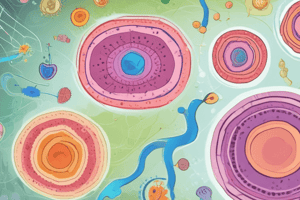Podcast
Questions and Answers
What is the central focus of cell biology?
What is the central focus of cell biology?
- Understanding cellular compartments (correct)
- Studying interactions with the extracellular environment
- Investigating cell metabolism
- Examining genetic material
Which organelle is responsible for energy production through oxygen metabolism?
Which organelle is responsible for energy production through oxygen metabolism?
- Vacuoles
- Ribosomes
- Chloroplasts
- Mitochondria (correct)
In plant cells, what is the organelle responsible for photosynthesis?
In plant cells, what is the organelle responsible for photosynthesis?
- Nucleus
- Chloroplasts (correct)
- Mitochondria
- Ribosomes
Which organelle is involved in storing lipids and proteins?
Which organelle is involved in storing lipids and proteins?
What type of collaboration has driven advances in cell biology?
What type of collaboration has driven advances in cell biology?
What techniques allow for a deeper understanding of interactions at the atomic level?
What techniques allow for a deeper understanding of interactions at the atomic level?
Flashcards are hidden until you start studying
Study Notes
Cell Structure and Organelles
Cell biology examines the fundamental processes occurring inside cells, including those related to structure, function, and interaction with the extracellular environment. Central to cell biology is the understanding of the various cellular compartments known as organelles, each with distinct roles and characteristics.
Basic Components of a Cell
A typical animal cell consists of several basic elements: the plasma membrane surrounding the entire cell, nucleus containing chromatin (genetic material), mitochondria producing energy through oxygen metabolism, ribosomes facilitating protein synthesis, and vesicles storing lipids and proteins. Plant cells have additional organelles such as chloroplasts for photosynthesis and vacuoles for water storage. Each component plays a vital role in maintaining cell homeostasis.
Importance of Integrating Disciplines
Advances in cell biology have often been driven by cross-disciplinary collaboration. Modern molecular approaches have significantly increased our knowledge of biological macromolecules and pathways, highlighting the importance of bringing physical sciences into biology research. Techniques such as cryoelectron microscopy, super-resolution imaging, and single-molecule detection allow for a deeper understanding of interactions at the atomic level.
Future Outlook
With continued integration of diverse methods, cell biology continues to push boundaries in prediction abilities. Combining experimental data with computational models enables researchers to simulate realistically how cells function in varied natural environments and under varying conditions. As technology improves, the field of cell biology stands to gain further insights into the complexities of life itself.
Studying That Suits You
Use AI to generate personalized quizzes and flashcards to suit your learning preferences.





